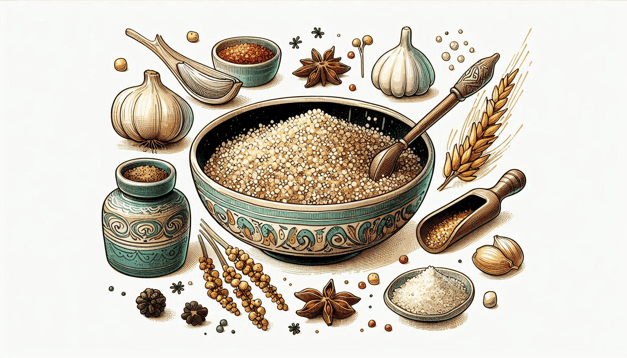Discover the Nutritional Power of Quinoa.
Discover the nutritional power of quinoa, an ancestral food that enriches our modern diet. Explore its history, varieties, and health benefits. You can download the recipe.
Angie Torres
6/13/20243 min read


I come from a Colombian family where I had never tasted quinoa, let alone used it in my practice as a nutritionist. It was in my current place of residence where I discovered its magic and the gifts it offers us. Therefore, I decided to write this article for those who do not know it and for those who have already included it in their dishes, so that they know a little more about its history and its role in nutrition.
Quinoa has overcome the barriers of time and geography to position itself as a superfood on the global table. Its cultivation originated in the surroundings of Lake Titicaca, between Peru and Bolivia and certain areas of Colombia, where it was venerated by pre-Hispanic civilizations more than 5,000 years ago. Although it was replaced by cereals with the arrival of the Spaniards, quinoa continued to be an essential food for many indigenous populations.
Currently, three varieties of quinoa are mainly recognized: white, red, and black. The white is the most common and versatile in the kitchen, the red stands out for its fiber and carbohydrate content, and the black, although more recent in the market, shares the antiquity of the others and is appreciated for its earthy flavor and crunchy texture, perfect for combining with vegetables and meats. There are more than 1200 known varieties, each adapted to its environment and with distinctive characteristics.
Quinoa is a resistant plant that tolerates a wide range of climates. Its seeds are a nutritional treasure, small and round, with a complete profile of essential amino acids, making it a complete protein source. It also provides carbohydrates, lipids, fiber, and minerals such as calcium, magnesium, iron, copper, and zinc, in addition to being rich in vitamin E, a powerful antioxidant.
More than a food, quinoa is a cultural and nutritional legacy that reflects the wisdom of our ancestors and the importance of maintaining food traditions. Its historical presence in the kitchen and the benefits it offers to our health make it deserving of a place in the diet of any person conscious of their well-being.
Incorporating quinoa into our diet is easy and beneficial. It can be prepared as a cereal, added to salads, used to thicken soups, or as a base for a nutritious breakfast. Its low glycemic index is ideal for diabetic patients and, being gluten-free, it is safe for celiacs.
However, quinoa contains saponins in its outer layer, bitter compounds that can cause digestive discomfort if not properly removed. These act as a natural barrier against fungi and bacteria. To remove the saponins, the quinoa must be washed under running water until it comes out clean, thus ensuring a pleasant culinary experience.
The Cultivation of Resilience: Quinoa in Agriculture
Quinoa is notable not only for its nutritional profile but also for its impressive agricultural resilience. It can grow in adverse conditions, from poor soils to high altitudes, and withstand extreme temperatures. This adaptability makes it valuable for food security, especially in areas impacted by climate change.
Nutrients in Depth: The Power of Quinoa
Quinoa is a nutritional treasure. It contains more protein than many grains and its protein quality is exceptional, with the presence of all essential amino acids. In addition, its high fiber content promotes digestive health.
This food is nutritionally complete. Its protein profile is remarkable, with 13% protein by weight, almost double that of rice. Quinoa also offers complex carbohydrates, which represent 69% of its weight, providing sustained energy. Fiber contributes to digestive health and a feeling of fullness, aiding in weight management.
As for fats, quinoa contains healthy fats, including omega-3 fatty acids, beneficial for cardiovascular health. It is a source of B-complex vitamins and vitamin E, known for its antioxidant properties.
The minerals present in quinoa are essential for various bodily functions, such as bone health and immune function. In addition, it contains bioactive compounds with antioxidant and anti-inflammatory properties.
Quinoa in Culture: Tradition and Modernity
Quinoa is a cultural symbol in Andean communities, forming part of rituals and festivities. Today, it has been rediscovered and valued in modern cuisine for its versatility. It has made a place in the kitchens of the world, adapting to a variety of dishes. Its unique texture and ability to absorb flavors make it ideal for culinary experimentation.
Nutritional Education: Quinoa in Public Awareness
As a nutritionist, I strive to educate the public about the inclusion of quinoa in a balanced diet, given its nutritional richness and delicious versatility.
Quinoa is a superfood that offers significant nutritional benefits. Its complete profile of amino acids, fiber, minerals, and healthy fats make it a valuable addition to any diet. It teaches us that nutrition involves understanding the historical and cultural value of foods, beyond calories. It is an ancestral grain that offers us incomparable nutritional wealth, quinoa is a true gift from nature.
Thank you for reading me.
